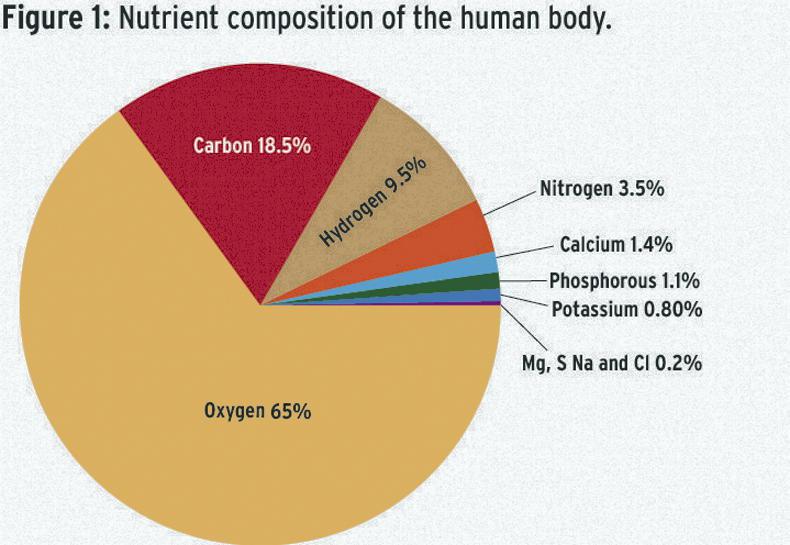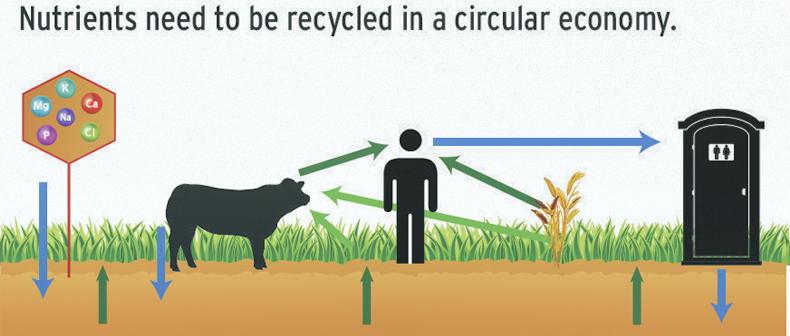Part of the understanding of sustainability is the process by which the earth’s nutrient resources circulate in and through food. Farmers apply fertiliser or nutrients for use in food production. Most of these are applied to the land, but a small amount can be applied directly to plants or fed to animals.
Humans get their nutrition through food consumption.
This is normally presented in terms of consumption of carbohydrates, protein, fats and other minerals, mainly through plants and a range of animal products. We consume these to get access to the basic nutrients that are essential for life.
Some plants are grown for direct human consumption in the form of vegetables, salads, fruit, pulses etc, while others are processed and consumed as drinks like beer, wine, spirits or eaten as bread. Animals’ products involve a range of meats and dairy products.
Some nutrients must be given directly to plants or animals to supplement their nutrition, either because the soil does not deliver them in adequate quantities, or because the animal cannot absorb enough of a specific nutrient as it passes through its digestive system.
Nutrients and animals
The principles of nutrition are broadly similar across plants, animals and humans. Nutrients are needed to fulfil vital biochemical functions to sustain life. Plants, animals and humans differ somewhat in their capability to absorb different nutritional compounds at different stages of life.
In farming, we commonly see feeds made specifically for baby, young and mature animals and for animals in the middle of their reproductive phases.
Babies get fed different foods to toddlers and teens must have adequate nutrition to fuel their rapid growth.
At later stages of life, the challenge is to balance intake with requirement and to reflect the altered ability of older people to digest certain foods.
People need nutrients just like plants and animals. Insufficient nutrient or an imbalance in nutrients will generally affect some aspect of a person’s growth and development.
Nutrient content of humans
Just six elements make up approximately 99% of the average human body. These are oxygen, hydrogen, nitrogen, carbon, calcium and phosphorus (see Figure 1). Interestingly, potassium use by humans is much less important than for plants and it is in a group of five elements which make up about 0.85% of the remainder.

These are sulphur, potassium, sodium, chlorine, and magnesium. All these elements are essential, but so are trace elements, which make up the other 0.15% of the body’s mass.
The three most abundant essential trace elements are iron, fluorine and zinc. Iron is essential for human health, as it is needed for haemoglobin, which transports oxygen in the blood. Fluorine is important for teeth. Zinc is required by many enzymes and is regarded as vital for our eyes and for the growth and functioning of reproductive organs.
Intake is normally in excess
While the percentages in Figure 1 are the normal nutrient make-up of an average living body, greater quantities of nutrients will normally be consumed on a daily basis. A proportion of the nutrient intake is held in the body and, like other animals, surplus nutrients are excreted. Surplus nutrients are consumed through all types of foods and liquids and they are excreted through faeces and urine.
While the nutrients present in the body at death end up in a graveyard or a crematorium, those excreted during life should naturally find their way back to the land from which they came to produce more food, just like with animals. This should be part of a normal nutrient cycling process, but there are additional concerns with human versus animal excrement, even if processed.

With modern tillage systems, virtually all nutrients are removed on a yearly basis – a one-way system. Nutrients are normally replaced with artificial sources and the return of the organic matter and surplus nutrients from food consumption would add to the sustainability and circularity of our farming systems.
Better ways must be found to return and reuse harvested nutrients, along with their organic matter benefit, to tillage land.
Where a crop is removed (grain or forage) the nutrient offtake is much higher compared with crops that are grazed in situ where excrement is returned.
Recycling
The nutrients we apply as artificial or organic fertiliser ultimately cycle through plants to end up mainly in the human food chain as plant or animal-based foods. Some of them remain in our bodies for their lifespan, while most are excreted and are potentially available for reuse in the food production system.
This recycling is an increasingly important nutrient source, as artificial nutrients remain expensive and scarce. It is increasingly important to remember that there are no new nutrients. They all exist somewhere and they are a finite resource.






 This is a subscriber-only article
This is a subscriber-only article










SHARING OPTIONS: